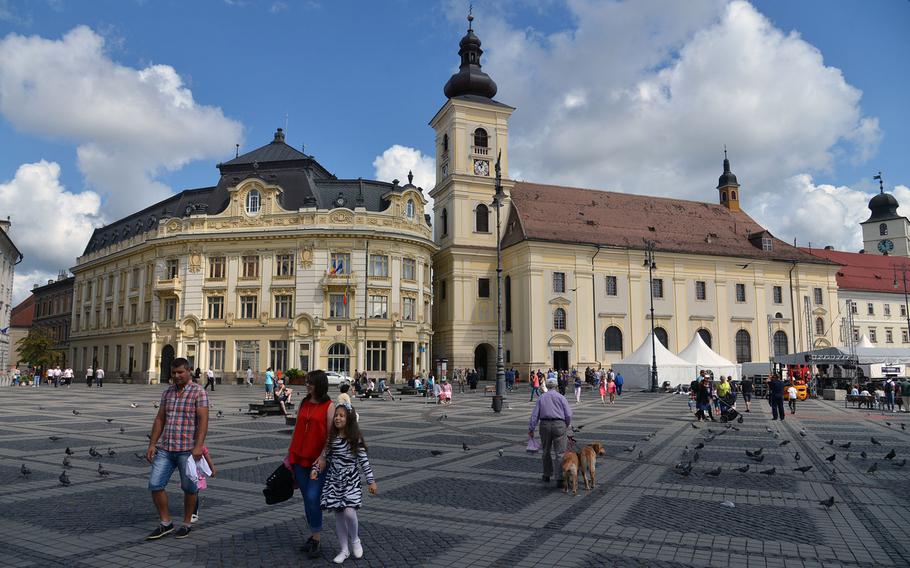
Sibiu's Piata Mare or Great Square, is the heart of the Romanian city. At center is the 18th-century baroque Catholic church. (Michael Abrams/Stars and Stripes)
Sibiu, Romania. Never heard of the place.
When I got assigned to photograph a military exercise nearby, my first thought was where the heck is that?
An internet search told me it was once called Hermannstadt. That rang a dim bell. Somewhere in my history books, I remember a town in Romania being settled by Germans in the Middle Ages.
When we arrived there, the next puzzle was why are there so many international tourists here? My traveling partner and I finally figured it out: It is on the vampire trail to Dracula’s castle.
Seems the count’s haunts are only about 90 miles down the road, and with an international airport, Sibiu is the place to start a journey through Transylvania. We didn’t have time to go to Vlad the Impaler’s castle, but we did have time to explore Sibiu.
There was plenty to discover.
The city’s Old Town is divided into two parts, the upper town and the lower town. As could be expected, the upper town was the wealthier part, with the lower town being where the working man lived.
The two are connected by two interesting staircases, the13th-century Pasajul Scarilor, or Passage of Steps, with arches and cobblestone stairs and the steep staircase that begins at the Stairs Tower and leads down to Piata Coroana in the lower town.
The heart of old Sibiu are the Piata Mare or Great Square and the Piata Mica, or Little Square.
When we arrived on a Thursday, there was a bustling market happening on the former and after doing a little sightseeing, we had dinner at one of the many restaurants that line the latter.
Walking from the one square to the other, we passed under the arch of the 13th-century Turnul Sfatului, or Council Tower. The next day we climbed it for a grand view of the city and the surrounding countryside. From here there is also a great view of the Evangelical Cathedral with its beautiful tile roof and steeple.
A street leads up from the lower town to the Piata Mica, splitting it in two. The pedestrian Podul Minciunilor, or Bridge of Lies spans it. Built in 1859, it was the first wrought iron bridge in Romania.
When there’s no market on Piata Mare, one of its main attractions is the playful fountain at its center. It squirts streams of water into the air at different intervals and strengths, surprising the children brave enough to play in it.
The Old Town is full of cobblestone streets and narrow passages. There is also a section of the city’s fortifications still standing along with a handful of defensive towers. As we discovered, they are a popular backdrop for wedding pictures.
Take time to check out is the Orthodox Metropolitan Cathedral. Built early in the 20th century, it is the second-largest Orthodox church in Romania.
There’s plenty more to discover wandering through Sibiu, including a couple of museums, churches and colorful historic houses. So, if you’re on your way to see the count or looking for an out-of-the-way place to visit, put Sibiu on your list.
abrams.mike@stripes.com Twitter: @stripes_photog